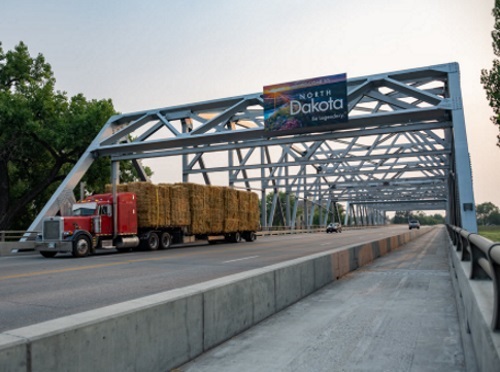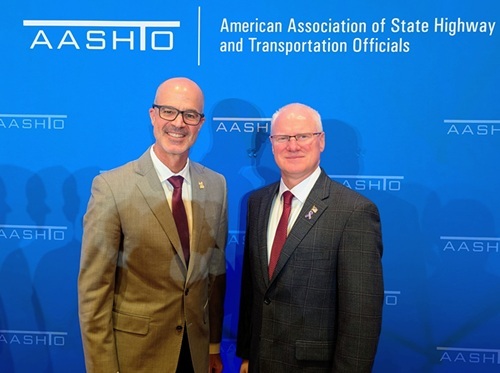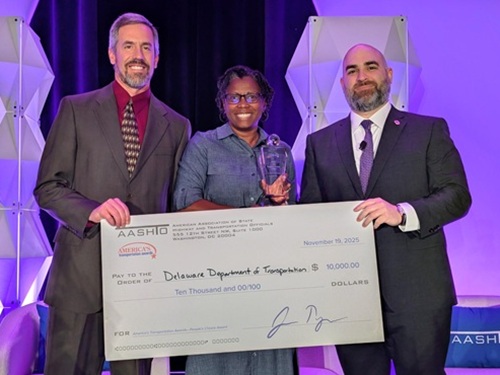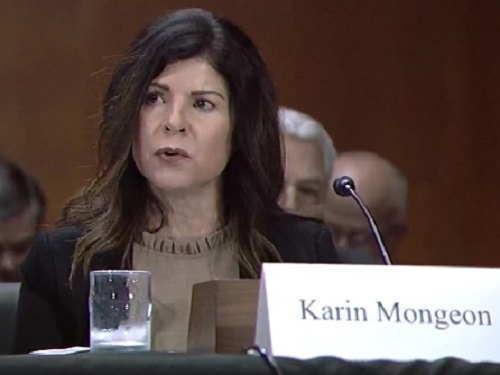Karin Mongeon (above), highway safety division director for the North Dakota Department of Transportation, recently testified on Capitol Hill at a Senate hearing aimed at understanding the roadway safety challenges facing the United States.
[Above photo via the Senate EPW Committee]
At that hearing – held by the Subcommittee on Transportation and Infrastructure within the Senate Committee on Environment and Public Works – Mongeon discussed a range of highway safety issues, including the successes of North Dakota’s statewide “Vision Zero” initiative and that effort’s goal to reduce motor vehicle crash fatalities and serious injuries to zero on the state’s roadways.
“[We are] focused on the fact that there is no single solution to the problem of motor vehicle crash fatalities,” she explained in her testimony. “It takes a comprehensive approach including education, outreach, enforcement, engineering, post-crash care, and more.”

Mongeon noted that North Dakota DOT – along with other state cabinet-level agencies and industry partners – originally launched North Dakota’s Vision Zero initiative in January 2018. She said that effort sought to “reinvigorate highway safety efforts,” to heighten public awareness to solving highway safety problems, and to continue to advance the decreasing fatality trend.
At the time, the North Dakota DOT was in the midst of an update to its Strategic Highway Safety Plan, which became its first Vision Zero Plan and subsequently that updated plan – for the five-year period 2018-2023 – coincided with the launch of Vision Zero.
“Due to a strong SHSP/Vision Zero Plan and vigorous strategy implementation by stakeholders, North Dakota reported 98 crash deaths at the end of calendar year 2022 – the lowest number of crash deaths in North Dakota in about 20 years,” Mongeon noted.
[Editor’s note: She also noted in her testimony that the North Dakota DOT participated in the American Association of State Highway and Transportation Officials Safety Summit in mid-October, which Mongeon said “renewed the collective state DOT collective commitment to a transportation system that is free of fatalities and serious injuries.”]

The agency’s Vision Zero plan also incorporates numerous infrastructure safety strategies, including: Constructing roundabout intersections; constructing high-tension median cable guardrail on the interstate system; constructing pedestrian improvements throughout the state, including rapid rectangular flashing beacons, enhanced signing and crosswalks, and leading pedestrian intervals; implementing road diets; installing roadway lighting; installing passing lanes and turn lanes on major freight corridors; and completing low-cost systemic projects on the state highway system, including enhanced intersection signing and pavement marking, curve signing, and intersection destination lighting.
“In addition to [those] items, we have by policy installed statewide edge and centerline rumble strips on the entire rural state highway system for over 13 years,” Mongeon added. “The North Dakota DOT is also one of the few states that funded and facilitated the development of Local Road Safety Plans for all 53 counties, 12 major cities, and four tribes in the state. Those safety plans included specific project submittals and resulted in the completion of many low-cost systemic safety measures throughout counties, cities, and reservations.”
She also noted that the agency began to design and implement Vision Zero Highway Safety Corridors or HSCs in 2019, which selects specific sections of highway based on data for low-cost infrastructure safety solutions, heightened driver education, and heightened law enforcement.
“Motorists driving through the HSCs see enhanced signing and pavement marking and law enforcement presence. Coordinated media and outreach activity educates the public about what they can expect as they travel through the HSCs,” Mongeon noted. “As we continue to develop more of the above listed projects, we are also installing our first reduced conflict intersections next year, several interstate system locations will have wrong way detection systems installed, and we will be upgrading state system edge and centerline pavement marking to wider lines.”
[Editor’s note: The Iowa Department of Transportation recently initiated a similar safety corridor effort for selected roadways under its purview.]
Above all, Mongeon said her agency is committed to provide as much opportunity to the public as possible to participate in those statewide roadway safety efforts.
“There are many opportunities for our partners and the public to engage in transportation safety planning and offer feedback through community outreach events, public meetings, public comment periods, and periodic surveys,” she pointed out. “We are committed to very wide outreach, to all communities.”
 Top Stories
Top Stories
New AASHTO Leadership Elected at 2025 Annual Meeting
November 21, 2025 Top Stories
Top Stories

